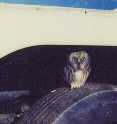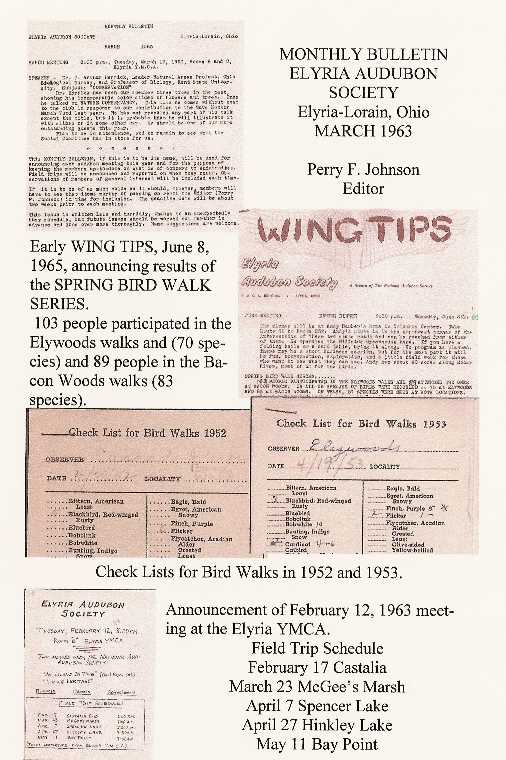

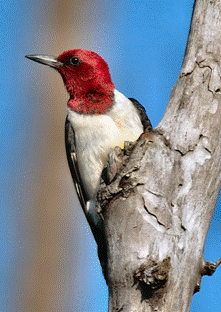
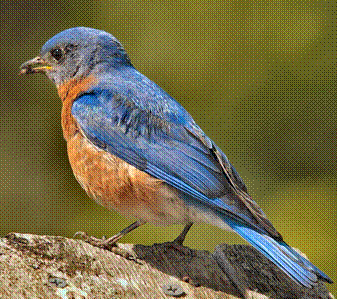
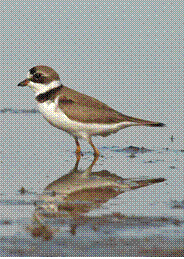
Photos by John Koscinski
EDITORS: JACK SMITH / HARRY SPENCER. PHOTOGRAPHER: JOHN KOSCINSKI
September 2007 Program Carlisle Visitors' Center, September 4, 7 PM Ecuador - Andes to Amazon Mark Purdy, President, Greater Akron Audubon Society Mark Purdy is a chemical engineer for Goodrich Corporation, but his real love is travel and nature. He and his wife have done nature/birding trips to every continent except Antarctica. He has been president of the Greater Akron Audubon Society since 2000. =============================================================================================================== Field Trip Saturday, September 15, 9 AM, Sandy Ridge Reservation ============================================================================================================== Young Birders Hike Saturday, September 8, 8 AM, Sandy Ridge Reservation =============================================================================================================== Past Board Meetings May 29 The Board elected the following officers for the 2007/2008 year: President: Harriet Alger First VP: Jack Smith Second VP: Bernie Pluchinsky Secretary: Arlene Ryan Treasurer: Joe Strong Committee chairs appointed for the same year are: Membership: Betty Lake, Bernie Pluchinsky Programs: Martin Ackermann Conservation: Wayne Shipman, Joe Strong, Harriet Alger Field Trips: Ken Austin, Joann Wagner Education: Dick Lee Social: Jenny Austin, Jean Sorton Publicity: Dave Bragg Wingtips: Jack Smith, Harry Spencer July 31 A. The Board approved a statement over President Harriet Alger's signature. It says: Black River Audubon is a local affiliate of the National Audubon Society and Audubon Ohio with over 500 members. It is an organization deeply concerned about the environment with conservation activities that include:
The members of the Black River Audubon Board endorse the following statement of principles and request that our elected representatives recognize the urgent need for new energy policies and practices to address the threat posed by global warming. RENEWABLE ELECTRICITY STATEMENT OF PRINCIPLES We strongly support increasing our use of homegrown renewable resources like wind, solar, geothermal, biomass to 20 percent of America's electricity by 2020. Increasing our use of renewable energy is critical to reducing global warming, pollution, protecting our environment, and strengthening the economy. More than twenty states and the District of Columbia have already enacted Renewable Electricity Standards (RES) and are reaping the benefits. In addition, ten states have increased or accelerated their standards. This policy has proven to be an effective, efficient, and popular driver of expanded renewable energy development. It is time to bring those benefits to the rest of the nation. Developing our renewable energy resources will create jobs, save consumers money, and bolster rural economies. Recent analyses by the Union of Concerned Scientists (UCS) found that requiring 20 percent of electric generation from renewable energy sources by the year 2020 would create over 355,000 new high-paying jobs and save consumers at least $49 billion on their electric and natural gas bills. In addition, by shifting away from fossil fuels, we can diversify and secure our energy supply while reducing global warming pollution. A 2006 analysis by U.S. PIRG found that by obtaining 20 percent of our electricity from renewable energy sources by 2020, we could cut global warming pollution over 500 million tons, the equivalent of taking approximately 89 million cars off the road. Similarly, a report released last month by the renewable energy scientists of the American Solar Energy Society indicates that renewable energy alone can help us reduce our global warming emissions 26-34 percent by 2050. The recently released U.N. Intergovernmental Panel on Climate Change report underscores the urgent need for these reductions. In time of rising energy costs and the threat of global warming impacts such as sea level rise, increased droughts and more intense tropical storms, we need a new energy future. Increasing our use of renewable energy is a critical step toward a cleaner, more secure energy future. That's why we strongly support increasing our use of renewable energy to 20 percent renewable energy by 2020. Sincerely, Harriet A. Alger, President B. Dates of Christmas Bird Counts chosen: Elyria, Saturday, December 22, 2007, Wellington, Saturday, December 29, 2007 C. Special Board Meeting: August 28, 2007, 6:30 PM, Harriet's house, 1505 W. Lakeview Blvd., Lorain D. Wing Watch: Dane Adams reported on the Wing Watch Organizing Committee's tentative plan for reorganization of Wing Watch. They will explore the interest in enlarging the number of counties covered from the current three to include all Ohio counties bordering Lake Erie. E. The Board accepted the fiscal report of Treasurer Joe Strong and Jack Smith for the fiscal year July 1, 2006 through June 31, 2007.
============================================================================================================== T Torpidity By Carol Leininger Torpidity is a state of inactivity that is brought about by certain physiological changes, such as greatly lowered heart rate, breathing rate, and metabolism, and a greatly reduced response to external stimulation. Common Poorwills have been known to enter a state of torpor for weeks at a time, not directly because of cold temperatures, but due to an inadequate supply of food -- insects. Hummingbirds are known to become torpid at night when their body temperature drops to within a few degrees of the environmental temperature. Because of their high metabolic rate, limited energy reserves, and inability to feed at night, such small birds would starve to death before morning unless they could minimize their energy losses. ================================================================================================================ By Dane Adams I walked today. I walk everyday. I walk for cardiovascular fitness. I walk simply to get from "A" to "B", but my favorites by far are the leisurely walks I take daily for my soul. Walking among the trees, wildflowers, mammals and birds calms, comforts and rejuvenates me. I feel elevated to a level of serenity that I experience nowhere else. I consider myself blessed. I wonder if, and hope that others experience this elation similarly. Regardless of the month, time of day, or even the temperature, nature unfailingly opens her heart and reveals yet another awe inspiring glimpse. What a tease she is, so alluring with her unending promise of more. ================================================================================================================ Which bird species might be seen or heard at selected areas during September, October, and November? The following chart attempts to answer that question for four locations: Sandy Ridge Reservation, Carlisle Reservation, Lorain Harbor including Lakeview Park, and French Creek Reservation. The lists are summaries of checklists recorded on Black River Audubon's Ebird site for those months during 2006. The numbers of checklists for each location are Sandy Ridge (25), Carlisle (66), Lorain Harbor (65), and French Creek (14). The letter A indicates that the species was identified on half or more of the checklists, B indicates identification on 10 to 49% of the checklists, C on less than 10%, and C1 indicates heard or seen only once. Sandy Ridge A. CANADA GOOSE, WOOD DUCK, AMERICAN WIGEON, MALLARD, NORTHERN SHOVELER, NORTHERN PINTAIL, GREEN-WINGED TEAL, RUDDY DUCK, PIED-BILLED GREBE, GREAT BLUE HERON, GREAT EGRET, AMERICAN COOT, MOURNING DOVE, BELTED KINGFISHER, RED-BELLIED WOODPECKER, DOWNY WOODPECKER, BLUE JAY, BLACK-CAPPED CHICKADEE, EUROPEAN STARLING, SONG SPARROW, AMERICAN GOLDFINCH B. GADWALL, AMERICAN BLACK DUCK, BLUE-WINGED TEAL, BUFFLEHEAD, HOODED MERGANSER, DOUBLE-CRESTED CORMORANT, GREEN HERON, TURKEY VULTURE, BALD EAGLE, SHARP-SHINNED HAWK, COOPER'S HAWK, RED-SHOULDERED HAWK, RED-TAILED HAWK, PEREGRINE FALCON, SORA, SANDHILL CRANE, KILLDEER, RING-BILLED GULL, ROCK PIGEON, CHIMNEY SWIFT, RED-HEADED WOODPECKER, HAIRY WOODPECKER, NORTHERN FLICKER, EASTERN WOOD-PEWEE, EASTERN PHOEBE, AMERICAN CROW, TREE SWALLOW, BARN SWALLOW, TUFTED TITMOUSE, WHITE-BREASTED NUTHATCH, BROWN CREEPER, GOLDEN-CROWNED KINGLET, RUBY-CROWNED KINGLET, EASTERN BLUEBIRD, AMERICAN ROBIN, CEDAR WAXWING, NASHVILLE WARBLER, YELLOW-RUMPED WARBLER, EASTERN TOWHEE, AMERICAN TREE SPARROW, CHIPPING SPARROW, SWAMP SPARROW, WHITE-THROATED SPARROW, WHITE-CROWNED SPARROW, DARK-EYED JUNCO, NORTHERN CARDINAL, RED-WINGED BLACKBIRD, COMMON GRACKLE, BROWN-HEADED COWBIRD, HOUSE SPARROW C. AMERICAN KESTREL, HERRING GULL, GREAT HORNED OWL, NORTHERN ROUGH-WINGED SWALLOW, CAROLINA WREN, HOUSE WREN, WINTER WREN, HERMIT THRUSH, GRAY CATBIRD, BLACK-THROATED GREEN WARBLER, COMMON YELLOWTHROAT, FIELD SPARROW, HOUSE FINCH C1. RING-NECKED DUCK, LESSER SCAUP, GREATER YELLOWLEGS, SPOTTED SANDPIPER, WILSON'S SNIPE, AMERICAN WOODCOCK, BLACK TERN, COMMON NIGHTHAWK, RUBY-THROATED HUMMINGBIRD, YELLOW-BELLIED SAPSUCKER, YELLOW-BELLIED FLYCATCHER, GREAT CRESTED FLYCATCHER, EASTERN KINGBIRD, WARBLING VIREO, RED-EYED VIREO, MARSH WREN, GRAY-CHEEKED THRUSH, WOOD THRUSH, BLACK-THROATED BLUE WARBLER, PALM WARBLER, BLACKPOLL WARBLER, LINCOLN'S SPARROW, ROSE-BREASTED GROSBEAK, EASTERN MEADOWLARK Carlisle A. CANADA GOOSE, RED-BELLIED WOODPECKER, DOWNY WOODPECKER, BLUE JAY, AMERICAN CROW, BLACK-CAPPED CHICKADEE, WHITE-BREASTED NUTHATCH, EASTERN BLUEBIRD, AMERICAN ROBIN, EUROPEAN STARLING, SONG SPARROW, NORTHERN CARDINAL, AMERICAN GOLDFINCH B. MALLARD, GREAT BLUE HERON, TURKEY VULTURE, RED-TAILED HAWK, KILLDEER, RING-BILLED GULL, MOURNING DOVE, BELTED KINGFISHER, HAIRY WOODPECKER, NORTHERN FLICKER, EASTERN WOOD-PEWEE, EASTERN PHOEBE, TUFTED TITMOUSE, CAROLINA WREN, RUBY-CROWNED KINGLET, GRAY CATBIRD, CEDAR WAXWING, YELLOW-RUMPED WARBLER, EASTERN TOWHEE, AMERICAN TREE SPARROW, FIELD SPARROW, WHITE-THROATED SPARROW, WHITE-CROWNED SPARROW, DARK-EYED JUNCO, RED-WINGED BLACKBIRD, EASTERN MEADOWLARK, RUSTY BLACKBIRD, HOUSE FINCH C. WOOD DUCK, HOODED MERGANSER, WILD TURKEY, GREEN HERON, RED-SHOULDERED HAWK, GREATER YELLOWLEGS, LESSER YELLOWLEGS , SPOTTED SANDPIPER, YELLOW-BILLED CUCKOO, CHIMNEY SWIFT, PILEATED WOODPECKER, WHITE-EYED VIREO, WARBLING VIREO, RED-EYED VIREO, HOUSE WREN, ORANGE-CROWNED WARBLER, BLACK-THROATED BLUE WARBLER, BLACK-THROATED GREEN WARBLER, PALM WARBLER, MOURNING WARBLER, COMMON YELLOWTHROAT, LINCOLN'S SPARROW, SWAMP SPARROW, ROSE-BREASTED GROSBEAK, COMMON GRACKLE C1. RUDDY DUCK, PIED-BILLED GREBE, BALD EAGLE, NORTHERN HARRIER, SHARP-SHINNED HAWK, COOPER'S HAWK, SOLITARY SANDPIPER, RUBY-THROATED HUMMINGBIRD, YELLOW-THROATED VIREO, BARN SWALLOW, BROWN CREEPER, GOLDEN-CROWNED KINGLET, GRAY-CHEEKED THRUSH, BROWN THRASHER, NASHVILLE WARBLER, BLACKPOLL WARBLER, AMERICAN REDSTART, CHIPPING SPARROW, INDIGO BUNTING, BROWN-HEADED COWBIRD Lorain Harbor A. CANADA GOOSE, MALLARD, RING-BILLED GULL, HERRING GULL, ROCK PIGEON, MOURNING DOVE, AMERICAN CROW, EUROPEAN STARLING, HOUSE SPARROW B. RED-BREASTED MERGANSER, DOUBLE-CRESTED CORMORANT, GREAT BLUE HERON, TURKEY VULTURE, COOPER'S HAWK, AMERICAN COOT, BONAPARTE'S GULL, GREAT BLACK-BACKED GULL, DOWNY WOODPECKER, BLUE JAY, RUBY-CROWNED KINGLET, NORTHERN CARDINAL, HOUSE FINCH, AMERICAN GOLDFINCH C. MUTE SWAN, AMERICAN BLACK DUCK, GREEN-WINGED TEAL, HOODED MERGANSER, COMMON LOON, BALD EAGLE, KILLDEER, LESSER BLACK-BACKED GULL, CASPIAN TERN, FORSTER'S TERN, BELTED KINGFISHER, NORTHERN FLICKER, BLACK-CAPPED CHICKADEE, HOUSE WREN, AMERICAN ROBIN, YELLOW-RUMPED WARBLER, BLACK-AND-WHITE WARBLER, AMERICAN TREE SPARROW, WHITE-THROATED SPARROW, DARK-EYED JUNCO C1. BLUE-WINGED TEAL, LESSER SCAUP, BUFFLEHEAD, HORNED GREBE, BLACK-BELLIED PLOVER, GREATER YELLOWLEGS, LESSER YELLOWLEGS, SOLITARY SANDPIPER, PECTORAL SANDPIPER, STILT SANDPIPER, SABINE'S GULL, COMMON TERN, BLACK TERN, CHIMNEY SWIFT, RED-HEADED WOODPECKER, BARN SWALLOW, WHITE-BREASTED NUTHATCH, EASTERN BLUEBIRD, NASHVILLE WARBLER, MAGNOLIA WARBLER, BLACKBURNIAN WARBLER, PALM WARBLER, BAY-BREASTED WARBLER, BLACKPOLL WARBLER, CHIPPING SPARROW, SONG SPARROW, RED-WINGED BLACKBIRD French Creek A. RED-BELLIED WOODPECKER, DOWNY WOODPECKER, HAIRY WOODPECKER, BLUE JAY, BLACK-CAPPED CHICKADEE, TUFTED TITMOUSE, WHITE-BREASTED NUTHATCH, CAROLINA WREN, GOLDEN-CROWNED KINGLET, RUBY-CROWNED KINGLET, AMERICAN ROBIN, EUROPEAN STARLING, YELLOW-RUMPED WARBLER, WHITE-THROATED SPARROW, NORTHERN CARDINAL, AMERICAN GOLDFINCH, HOUSE SPARROW B. CANADA GOOSE, TURKEY VULTURE, MOURNING DOVE, YELLOW-BILLED CUCKOO, RUBY-THROATED HUMMINGBIRD, YELLOW-BELLIED SAPSUCKER, NORTHERN FLICKER, EASTERN WOOD-PEWEE, EASTERN PHOEBE, BLUE-HEADED VIREO, RED-EYED VIREO, AMERICAN CROW, BROWN CREEPER, GRAY-CHEEKED THRUSH, SWAINSON'S THRUSH, HERMIT THRUSH, GRAY CATBIRD, CEDAR WAXWING, NASHVILLE WARBLER, MAGNOLIA WARBLER, BLACK-THROATED GREEN WARBLER, BLACKPOLL WARBLER, BLACK-AND-WHITE WARBLER, AMERICAN REDSTART, WHITE-CROWNED SPARROW, DARK-EYED JUNCO C1. NORTHERN HARRIER, SHARP-SHINNED HAWK, RING-BILLED GULL, BLACK-BILLED CUCKOO, CHIMNEY SWIFT, BELTED KINGFISHER, GREAT CRESTED FLYCATCHER, WHITE-EYED VIREO, YELLOW-THROATED VERIO, WARBLING VIREO, EASTERN BLUEBIRD, CHESTNUT-SIDED WARBLER, CAPE MAY WARBLER, BLACK-THROATED BLUE WARBLER, BLACKBURNIAN WARBLER, BAY-BREASTED WARBLER, MOURNING WARBLER, WILSON'S WARBLER, SCARLET TANAGER, EASTERN TOWHEE, SONG SPARROW, ROSE-BREASTED GROSBEAK, COMMON GRACKLE, HOUSE FINCH ================================================================================================================================== THE GRAY CATBIRD By Jack Smith This photo by John Koscinski is an excellent picture of the Gray Catbird, Dumetella carolinensis, commonly found in our area. The genus name dumetella means little thicket- dweller. The species name carolinensis means Carolina where the species was first discovered and named. Gray Catbirds are about 8 to 9 ¼ inches long with a wingspan of 11 to 12 inches. The common name, Gray Catbird, is appropriately named because of its mostly gray color. Only the head and tail are blacker and the undertail coverts are reddish. These non-gray features often are not seen. Males and females are identical and can only be told apart when the male flashes his red tail underparts. The species is a common summer bird nesting in most of the United States and Southern Canada. The west-southwestern states are the exception. Gray Catbirds winter in the Southeastern United States, Mexico, Central America, and the West Indies. The birds migrate mostly at night, when (especially in the fall) many collide with tall buildings and TV towers,. Males usually come back a week earlier than the females. These males incessantly sing their two-note imitations of many different birds. Possibly this discourages other species of birds from establishing nests in a catbird-claimed area. The habitats selected are shrubby, bushy areas at the edges of forests and swamps, brushy fallow fields, and home gardens, which have shrubs like lilacs and snow berries, etc. Early April is the time of spring arrival in our area. In early spring of last year, a male chose our backyard garden, singing constantly for several days. But he left. Apparently he could not get a female to accept him or our garden area. The Stokes Guide to Bird Behavior Vol. 1 explores the visual and auditory displays in catbird territorial establishment and courtship activity. The authors point out that much research is needed concerning the meaning of these displays. But they do present the following interpretation of catbird behavior and displays: Body Fluff, possibly represents a territorial dispute; Raised Wing, may indicate the presence of a predator near nest; Wing Flick, possibly a coordinating signal to female. Auditory displays are: Long Solitary Bursts of Song by a male, which could indicate territory establishment, courtship, or breeding. Soft Male Song may signal an aggressive encounter with a predator. Meow Call by either Male or Female could indicate encounters with other catbirds, or courtship or breeding. Ratchet Call, a short grating call by either male or female may be an alarm call. After courtship and breeding, a female starts nest-building with little help from a male. She chooses a site three to ten feet above ground in a shrubby, bushy area. The cup-like nest, constructed from twigs, plants, leaves, and sometimes trash, is lined with rootlets and other fine plant materials. A female usually lays 3 or 4 eggs, greenish blue with a few red spots. For twelve to fourteen days the female incubates the eggs as the male remains nearby to act as protector. Both parents feed various insects to the hatchlings. The young leave the nest after 10 to 11 days. An adult pair may have a second brood. Especially in the fall, catbirds eat many berries. In fact, half or more of catbirds’ diet is often vegetable matter. Populations of Gray Catbirds are declining in some areas, particularly the Southeast. References: Guide to Bird Behavior, Vol. 1, Donald & Lillian Stokes; Lives of North American Birds, Kenn Kaufman; The Audubon Society Encyclopedia of North American Birds, John K. Terres; Birds of Cleveland, edited by Arthur B. Williams, PHD. ============================================================================================================= THE FASCINATING PENNY-WEIGHT CREATURE By Jack Smith This John Koscinski photo is an excellent portrait of a female Ruby-throated Hummingbird, Archilochus colubris (no one has trouble identifying this bird), which nests only in the Midwest and eastern United States and southern Canada. In contrast, fifteen hummingbird species, but not ruby-throats, spend at least part of the year in the Western United States. For several years now, Jean and I have placed 6 hummingbird feeders in our backyard with much success attracting ruby-throats. Last year, in the summer months, we counted at one time as many as seventeen individuals. This count is only approximate because counting accurately is not an easy job. The birds zip back and forth, up and down, sideways, and every other way. We have a little oasis for hummingbirds in the middle of the buildings and asphalt jungle of the downtown area of Elyria – 300 feet from the new County Justice Center. Over the years we have tried to encourage hummingbird visits, through various plantings of shrubs, small trees, perennials, and the use of birdfeeders, feathered friends, butterflies and other wildlife. Though it involves a small area, doing this has been reasonably successful. The Ruby-throated Hummingbird is one of the most interesting and fascinating of our summer residents. We often sit on the bench and observe both male and female ruby-throats take up territorial positions guarding the feeders against a rival intruder. The way they zoom up and sideways reminds us of aerial combat in WWII. This little bird, 3 – 3 ¾ inch long with a wingspread of 4 to 4 ¾ inches, weighs between 1/10 and 1/7 of an ounce. (That is between one and two pennies in weight) The birds travels long distances between summer residence and winter quarters, which can be as far south as Panama. Some ruby-throats are known to fly over the Gulf of Mexico (about 3,000 miles). How can the birds store enough energy in fat to enable it to do this? This small marvel of engineering has developed over millions of years of evolution. This little one-penny bird can hover, fly backwards, sideways, straight upwards, and upside down. Individuals have been observed flying with speeds up to 60 mph and with up to 75 wing-beats per second. In spring males arrive here before the females. Some evidence points to hummingbirds following the migration route of Yellow-bellied Sapsuckers. The sapsuckers open many holes in trees, providing a syrupy liquid with about the same consistency as nectar. This might be an explanation of the northern arrival of ruby-throats before nectar-bearing flowers bloom. (Ruby-throats have been observed defending sapsucker-drilled trees. Ornithologists have suggested that ruby-throat-territory includes sections of Canada, including Alberta where sapsucker activity provides sap. ) Stokes in Guide to Bird Behavior indicates needed research to understand fully the following ruby-throat actions and behaviors: Pendulum Arc Flight in which a male flies back and forth along the path of a wide arc, rising on each side by three to forty feet. This behavior could indicate aggressive encounters serving some courtship function and accompanied by buzzing sounds at the bottom of the arc, believed to be made by the wings and tail; Vertical Flight in which two birds fly up and down facing each other about a foot apart. Again this could be aggressive or courtship display; Horizontal Flight in which a bird flies back and forth horizontally. This behavior again could be aggressive or courtship display or both; The Tail Spread in which a bird fans it’s tail with buzzing and twittering. This behavior could be aggressive or courtship display or both followed by copulation. After copulation, male and female go their separate promiscuous ways. The female finds a small horizontal limb from 4 to 50 feet above ground (usually 20 ft) where she builds a small nest anchored to a limb with spider threads or tent-caterpillar silk. It is lined with down from milkweed, ferns or thistles, etc. She covers the outside with lichens and moss, providing excellent camouflage. She completes the nest in a usual time between one day and a week. The nest looks like a small knot as big as a walnut with inside diameter of ¾ to 1 inch and a depth of 1 to 1 ½ inches. She lays two white eggs, and incubates them for about 16 days before they hatch. For the next 20-22 days she feeds the young in the nest. Then the young take their first flights. Their food consists mostly of small insects, caught by the mother in much the same manner as that of a flycatcher. Every 10 minutes she must supply herself with enough food, nectar and insects. What a chore! In the fall, the birds begin their trip south seemingly following blooming jewelweed, especially spotted touch-me-not, Impatiens capentsis, which blooms later than its cousin, I. pallida. Sometimes on cold nights hummingbirds will go into a state of torpor, in which its temperature may drop many degrees with heartbeat rates dropping from the normal 1,260 beats per minute to 50 beats per minute. Without this state of torpor, on cold nights, the bird would run out of energy and die by morning. In the morning body temperature may require an hour to reach the flying temperature of 86 degrees. Other interesting facts about Hummingbirds are: An average man would have to eat 285 pounds of hamburger every day to maintain the high metabolic rate of a hummingbird, and Hummingbirds need to feed for 30 to 60 seconds 5 to 8 times an hour. (Try taking the normal hummingbird 250 breaths per minute.) . References: Guide to Bird Behavior, Vol 3, Donald & Lillian Stokes; Lives of North American Birds, Kenn Kaufman; The Audubon Society Encyclopedia of North American Birds , John K. Terres; Hummingbird Book, Donald & Lillian Stokes. ================================================================================================================= Black River Audubon Society and Lorain County Metro Parks plan to establish a Black River Young Birders’ Club (BRYBC) for 12-18 year olds. Both organizations are dedicated to this project to counteract the nature-deficit disorder that many teens are experiencing in today’s technological world. The BRYBC program will offer one hike/program per month on a Saturday or Sunday, beginning with hikes on September 8 and October 13, Sandy Ridge, 8 AM. Some binoculars will be available for those who do not have them. Adult leaders will also have a scope for use by the group. Young people who join will be able to participate in the organization of the Club and its activities. Parents will be encouraged to participate. In addition to notices in Black River Audubon’s WINGTIPS and web site, LCMPD will publish the scheduled activities in Arrowhead and provide other support services to publicize the program. Black River Audubon is affiliated with the Ohio Young Birder's Club (OYBC), (ohioyoungbirders.org.) sponsored by Black Swamp Bird Observatory. Teen members of the BRYBC will be eligible to join OYBC with dues in that organization of $5/yr. No membership fee is required for the BRYBC. ================================================================================================================ Jill Lewandowski, who works at the Lorain Post Office, took this picture about ten year ago in the parking lot of the old Post Office on Broadway.
================================================================================================================ Photo courtesy of Lorain County Metro Parks Memories of Perry F. Johnson Former editor of WINGTIPS Perry Johnson, who was also both founding member and former president of the Black River Audubon Society, died at age 93 in June 2007. Here we pay tribute to his long service and many contributions to the Chapter. The Chapter, first called the Elyria Audubon Society, was an outgrowth of the spring birding walks in Elywoods started in 1950 under the sponsorship of the Cleveland Museum of Natural History. According to the Chapter's archives, which were started by Perry and continued by Jack Smith, James Akers led the first spring walk. His leadership continued for two more years, during which time the walks became so popular that the birders were split into groups. F. M. Phelps, Dale Kellogg, and Elizabeth Yoder contributed leadership in 1951. In 1952 P. F. Johnson and Jack F. Smith enlarged the leadership corps again. As a participant in the walks, founding member Norma Kraps met Perry. "Perry was very good as a guide because he pointed out all the birds and their songs", she stated recently. "Perry was very mild mannered, and everybody learned a great deal from him." Norma also told of conversations with others who were affected by Perry's love of nature. Norma's son, Bart, remembered a Fifth-Grade-class hike with Perry at the old Camp Iss-See-Kes. Perry pointed out Yellow-bellied Sapsuckers and their little holes all around some trees. The kids were much interested. Helen Ketcham recalled walking with her husband and Perry at Charlemont. At one point Perry said "That's a Henslow's Sparrow over there." They could hear it but could not see it. Later while walking through a field, Perry pointed out the sparrow. Helen also recalled Perry collecting all the bird sightings by Audubon members, organizing them, and placing them in a newsletter, the forerunner of WINGTIPS. Norma stated that several others remembered that Perry was very casual about pointing out things, and didn't make a big issue if someone couldn't see them. He knew the birds, flowers, and trees. He was an all around naturalist. Nancy Miller remembered her personal experience with Perry. "When I was a biology teacher at Elyria Northwood School in about 1970, Perry Johnson talked about birdlife to my ninth-grade biology club. He was a good teacher and a most pleasant person, and the students enjoyed his talk." A few examples of some of the early records preserved originally by Perry and now kept in Jack Smith's files are shown below.
|
|


